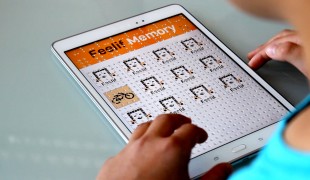- 2949
- 251
- 2
- 3
- 0
- Help Ukraine
About the solution
Read Read consists of an interface which is composed of moveable tiles, each featuring letters or phonetic sounds, which correspond to braille symbols. Users interact with the Read Read, manipulating tiles to form words on a conductive grid and touching tiles to hear an audio representation of each letter or sound.
Alex is a graduate of the Harvard Graduate School of Education. He noticed his students were performing well, but they would also tend to forget the new things they learned over time. “My students were actually getting worse in between our sessions. And I saw this as a huge problem.” Alex realized the problem was that the students didn’t have a chance to practice sounds and letters independently.
That’s when the inventor asked himself: “I’m spending the majority of my time sitting beside students and pointing to a letter and saying the sound. What if I could automate that process?”. And so Read Read was born.
When someone touches one of the 26 tiles of the Read Read, a voice pronounces the sound and describes its Braille symbol. Tiles can be moved around and positioned on a bar at the bottom of the device to form words. By passing their fingers horizontally, kids can hear the sound of words and feel the complete Braille translation with their fingertip.
Each tile has a large print letter or phonetic sound and corresponding braille symbol. The user can assemble the tiles to spell out words on a conductive, magnetic grid. When the Braille portion of a tile is touched while placed on the grid, the Read Read articulates the letter’s name or the sound that the letter makes, depending on the mode to which the device is set. The connection between the audio and lettered tiles mimics the interaction of a literacy specialist practicing one-on-one with a student, yet removes the need for the instructor’s constant presence.
To ensure efficacy, functionality, and ease of use, Alex conducted a successful twelve-week pilot of the Read Read at the Perkins School for the Blind. Users testing the prototype included students who are blind, students who are visually-impaired, and students on the Autism spectrum, each with varying needs.
Alex launched a Kickstarter campaign to manufacture 400 Read Read devices minimum, to be used by blind students living in the USA.
At the Harvard UDL Expo in 2016, The Read Read won the award for the Best New and Innovative UDL Technology.
Adapted from: http://bit.ly/2B8M9Ci
More info: https://www.thereadread.com/
This solution shall not include mention to the use of drugs, chemicals or biologicals (including food); invasive devices; offensive, commercial or inherently dangerous content. This solution was not medically validated. Proceed with caution! If you have any doubts, please consult with a health professional.
DISCLAIMER: This story was written by someone who is not the author of the solution, therefore please be advised that, although it was written with the utmost respect for the innovation and the innovator, there can be some incorrect statements. If you find any errors please contact the patient Innovation team via info@patient-innovation.com
-
-
752
-
2
-
12843

Feelif is a multimedia device for blind and visually impaired people
COMMUNICATION: Communicating, whether by speaking, listening, or other means
Reading
Video gaming
Blindness
Visual Impairment
Congenital Deafness
Hearing Disorders
App (Including when connected with wearable)
Videogame
Educational/Leisure device (book, toy, game...)
Vision problems
Hearing loss or ringing in the ears (tinnitus)
Managing Neurological Disorders
Improving Speech and Communication
General and Family Medicine
Medical Genetics
Neurology
Ophthalmology
Otorhinolaryngology
Pediatrics
Slovenia
-
-
-
267
-
0
-
3322

Mom Abby Ekmark creates Autism Safety Toolkit Inspired by her son Rudy Alejos
CAREGIVING
COMMUNICATION: Communicating, whether by speaking, listening, or other means
Autism
5 Senses support devices: (glasses, hearing aids, headphones...)
Book/Comic
Strategy/Tip
Educational/Leisure device (book, toy, game...)
Promoting self-management
Managing Neurological Disorders
Building Supportive Community Relationships
Promoting inclusivity and social integration
Raise awareness
Caregiving Support
Child and Adolescent Psychiatry
General and Family Medicine
Neurology
Pediatrics
United States
-
-
-
568
-
0
-
9152

Eye controlled communication devices
COMMUNICATION: Communicating, whether by speaking, listening, or other means
CAREGIVING
Cerebral Palsy
Assistive Daily Life Device (to help ADL)
Assistive Technology access
Recovering cognitive function
Promoting self-management
Managing Neurological Disorders
Promoting inclusivity and social integration
Improving Speech and Communication
Neurology
Ophthalmology
Pediatrics
United States
-
 en
en